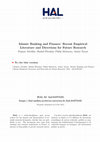Papers by Philip Molyneux

The paper examines the features of private banking business in Europe and focuses on the key role... more The paper examines the features of private banking business in Europe and focuses on the key roles of client segmentation, retention and acquisition. There has been substantial growth in private banking business over the last decade or so as commercial banks have targeted both the 'mass-affluent' and more upmarket high net worth individuals (HNWI’s). The combined amount of investable assets at the disposal of these two groups amounts to around Euro 6 trillion and a wide range of banks, investment firms and other operators have focused on devising strategies aimed at grabbing a share of this potentially lucrative market. The private client wealth management industry in Europe remains relatively fragmented although a few major players have emerged and consolidation is an ongoing theme in the sector. Given the commercial opportunities afforded by this business area the increased complexity of clients needs continues to be a critical strategic issue for industry participants. Th...

This paper investigates how executive compensation affects bank efficiency in China. Using commer... more This paper investigates how executive compensation affects bank efficiency in China. Using commercial bank data from 2004 and 2011, this study captures the period of major change in terms of bank compensation in the country and the effects of the financial crisis. It is found that higher compensation to executives reduces bank efficiency and this negative impact becomes more severe during the financial crisis. In contrast, a higher number of unpaid non-executive directors in the boardroom improves bank efficiency. However, this positive influence becomes weaker when banks face financial crisis. By further focusing on the board composition in the listed banks using propensity score matching, we find a difference between the treatment effects of non-executive directors of listed and those of non-listed banks. This result reveals that nonlisted banks would have benefited from listing by having monitoring and advisory services of non-executive directors. Such a benefit, nevertheless, mi...

This paper examines the recent empirical literature in Islamic banking and finance, highlights th... more This paper examines the recent empirical literature in Islamic banking and finance, highlights the main findings and provides a guide for future research. Early studies focus on the efficiency, production technology and general performance features of Islamic versus conventional banks, whereas more recent work looks at profit-sharing and loss-bearing (PSLB) behaviour, competition, risks as well as other dimensions such as small business lending and financial inclusion. Apart from key exceptions, the empirical literature suggests no major differences between Islamic and conventional banks in terms of their efficiency, competition and risk features (although small Islamic banks are found to be less risky than their conventional counterparts). There is some evidence that Islamic finance aids inclusion and financial sector development. Results from the empirical finance literature, dominated by studies that focus on the risk/return features of mutual funds, finds that Islamic funds perf...
European Financial Management, 2020
Using a sample of 440 Italian banks over 2007-2016, we find low interest rates motivate banks to ... more Using a sample of 440 Italian banks over 2007-2016, we find low interest rates motivate banks to expand their fee and commission income and to restructure their securities portfolios. A granular breakdown suggests banks grow non-interest income in various ways including portfolio management, brokerage and consultancy services and increase fee income from current account and payment services. In addition, banks re-balance securities portfolios away from those 'held-for-trading' to securities 'available-for-sale' and 'held-to-maturity'. Our findings allude to different behaviour between large and small banks: while larger banks increase brokerage, consultancy and portfolio management services, smaller banks generate fees from customer current accounts.
International Review of Financial Analysis, 2016
This paper explores the effects of earnout contracts used in US financial services M&A. We use pr... more This paper explores the effects of earnout contracts used in US financial services M&A. We use propensity score matching (PSM) to address selection bias issues with regard to the endogeneity of the decision of financial institutions to use such contracts. We find that the use of earnout contracts leads to significantly higher acquirer abnormal (short-and long-run) returns compared to counterpart acquisitions (control deals) which do not use such contracts. The larger the size of the deferred (earnout) payment, as a fraction of the total transaction value, the higher the acquirers' gains in the short-and long-run. Both acquirer short-and long-run gains increase when the management team of the target institution is retained in the post-acquisition period.
International Journal of Finance & Economics, 2018
This study explores the implications of Prompt Corrective Action (PCA) and the Troubled Asset Rel... more This study explores the implications of Prompt Corrective Action (PCA) and the Troubled Asset Relief Program (TARP) on the behavior of non-performing loans (NPLs) and real estate non-performing loans (RELs) in the U.S. over 1984-2015 using a Markov switching framework. We find that NPLs and RELs exhibit pronounced episodic behavior switching between non-stationary and stationary regimes. PCA and TARP have a significant impact on banking sector stability by influencing the probability of switching from non-stationary regimes to stationary regimes and by reducing the level of NPLs and RELs. These results are robust to various model specifications and have important implications for bank regulation as well as for the formulation of macro stress-testing.

The British Accounting Review, 2017
Over the past decade or so, banks have been affected by an array of shocks, which have transforme... more Over the past decade or so, banks have been affected by an array of shocks, which have transformed the industry. The global financial crisis of 2007-2008 coupled with the euro sovereign debt crisis of 2010-2012 and the subsequent recessions in many countries all combined to create a new macroeconomic environment with slower economic growth, low (or negative) interest rates and a new policy environment (where credit and quantitative easing and other alternative monetary policies are prevalent). All these forces have affected the performance and strategies of banks. Extensive regulatory and supervisory reforms have also taken place in order to reduce the risks in the banking and wider financial services sector (Berger, Molyneux and Wilson, 2015). In the United States, the Dodd-Frank Wall Street Reform and Consumer Protection Act of 2010 has introduced controls designed to reduce the likelihood of future taxpayer bailouts of major banks by limiting proprietary trading and other volatile business areas. Similar major reforms have taken place in the European Union, not least the moves to create a European Banking Union and the introduction of a Single Resolution Mechanism that became partially operational after the x Corresponding editor. * The Guest Editors would like to thank the General Editors, Professor Nathan Joseph and Professor Alan Lowe for commissioning this special issue and for providing advice and guidance throughout the process. Thanks also go to Shereen Awan at the British Accounting Review and Shona Deigman at the University of St Andrews for administrative assistance. We wish to thank the scientific committee, discussants and participants at the Contemporary Issues in Banking Conference held at the University of St Andrews in December 2015 for the useful comments and suggestions on all the papers submitted to this special issue, and to the referees for further comments and suggestions post submission. Finally, and most importantly we thank the authors of the papers included in the special issue for their valuable contributions in enhancing our understanding of contemporary issues in banking, The usual disclaimer applies.
An Introduction to Global Financial Markets, 2016
The Palgrave Handbook of European Banking, 2016
This chapter outlines recent features of UK banking including an evaluation of the regulatory ref... more This chapter outlines recent features of UK banking including an evaluation of the regulatory reforms outlined in the Independent Commission on Banking (known as the Vickers Commission), of September 2011 and incorporated into the UK Financial Services (Banking Reform) Act of 2013. Other regulatory issues, such as the bank levy (a tax on bank debts introduced in 2011) and the surcharge on bank profits (introduced in the summer budget of 2015) are also covered. We then briefly compare these changes with EU and US legislation and consider UK views on the European Banking Union. We then analyse the changing industry structure, performance and the role of the new challenger banks. We then conclude.
An Introduction to Global Financial Markets, 2016

Financial Exclusion, 2005
The US banking and financial services industry is one of the most advanced in the world. In many ... more The US banking and financial services industry is one of the most advanced in the world. In many respects, the US is a kind of ‘pacemaker’ in financial services development for other countries. Like the UK, financial exclusion is a major issue in the US; strong Government affirmative action has been one noteworthy response in the US. In all countries experiencing and reacting to financial exclusion, the banks are seen as an indispensable and integral part of the response mechanism. At the same time, one has to be aware of the institutional context of different countries in explaining financial exclusion, its economic consequences and the appropriate policy responses. The present chapter focuses on the US and what is clear is that the rise of deregulation in financial services sectors, intensifying competition and the rise of the ‘value maximisation’ model have exposed a growing need to tackle financial exclusion. US experiences (as probably the most strongly market-orientated banking system in the world) correspond closely to those of the UK, although the approach has been more legislation based. There are also important institutional differences between the US and UK (for example, the respective roles of the post office, credit unions and Government affirmative action).

Financial Institutions and Markets, 2010
As in many other countries, the banking market in the U.K. has undergone radical transformation s... more As in many other countries, the banking market in the U.K. has undergone radical transformation since the onset of the mid-2007 credit crisis. What was once a profitable, innovative, and dynamic industry has virtually collapsed and now major banks are state owned, the government has had to inject massive funds to support lending, and a crisis has ensued. The collapse of global real estate markets prompted by the U.S. sub-prime crisis, is usually put down as the main causes of the crisis. Also, excessive risk-taking by banks and inappropriate governance structures have been highlighted as other major factors that led to the meltdown. Of course, the environment that led up to these problems had been created over the last 25 years and was mainly driven by domestic deregulation as well as various other forces that changed the supply-and-demand characteristics of the financial services industry. In this context, this chapter aims to review the structural features of the U.K. banking industry, including an analysis of the credit crisis and how it unravelled. We then review the recent performance of U.K. banks and illustrate that up to 2006–2007, they were among Europe’s best-performing financial firms. However, the returns of major U.K. banks collapsed in 2008 (e.g., RBS made a loss of minus 43%!). Finally we focus on the regulatory environment, with particular attention on recent changes and their impact on the sector.

Journal of Economic Surveys, 2015
This paper examines the recent empirical literature in Islamic banking and finance, highlights th... more This paper examines the recent empirical literature in Islamic banking and finance, highlights the main findings and provides a guide for future research. Early studies focus on the efficiency, production technology and general performance features of Islamic versus conventional banks, whereas more recent work looks at profit and loss-sharing (PLS) behaviour, competition, risks as well as other dimensions such as small business lending and financial inclusion. Apart from key exceptions, the empirical literature suggests no major differences between Islamic and conventional banks in terms of their efficiency, competition and risk features (although small Islamic banks are found to be less risky than their conventional counterparts). There is some evidence that Islamic finance aids inclusion and financial sector development. Results from the empirical finance literature, dominated by studies that focus on the risk/return features of mutual funds, finds that Islamic funds perform as well, if not better, than conventional funds-there is little evidence that they perform worse than standard industry benchmarks. Some recent evidence, however, suggests that Islamic bond (Sukuk) issuance destroys value for shareholders.

SSRN Electronic Journal, 2014
We investigate ownership effects on capital and adjustments speed to the target capital ratio in ... more We investigate ownership effects on capital and adjustments speed to the target capital ratio in China from 2000 to 2012 and find that state-owned banks hold higher levels of capital than banks of other ownership types. Foreign banks are more highly capitalized than local non-state banks but under-capitalized compared with the bigger non-state banks with nationwide presence. Foreign banks adjust risk-weighted capital towards their optimal targets at a slower speed than domestic banks, while foreign minority ownership results in a faster adjustment process. Capital is positively influenced by profitability, asset diversification and liquidity risk, but negatively influenced by bank market power. Capital ratios typically co-move with the business cycle although this relationship is reversed during the crisis period due to active government intervention. Our results are robust to various modelling specifications and have important policy implications.
SSRN Electronic Journal, 2009
The recent period of crisis in credit markets has highlighted the crucial role of bank risk takin... more The recent period of crisis in credit markets has highlighted the crucial role of bank risk taking. Our paper assesses the inter-temporal relationships among bank efficiency, capital and bank risk-taking in the EU-26 commercial banking industry between 1995 and 2007. Our results support the bad management-, luck-, cost and revenue skimping hypotheses. Overall, our paper provides evidence that higher performance (enhanced efficiency) has been not related to higher managerial skills, rather to cost and revenue skimping and bad management.

SSRN Electronic Journal, 2018
Since 2012 several central banks have introduced a negative interest rate policy (NIRP) aimed at ... more Since 2012 several central banks have introduced a negative interest rate policy (NIRP) aimed at boosting real spending by facilitating an increase in the supply and demand for bank loans. We employ a bank-level dataset comprising 6558 banks from 33 OECD member countries over 2012-2016 and a matched difference-in differences estimator to analyze whether NIRP resulted in a change in bank lending in NIRP-adopter countries compared to those that did not adopt the policy. Our results suggest that following the introduction of negative interest rates, bank lending was weaker in NIRP-adopter countries. The result is robust to a wide range of checks. This adverse NIRP effect appears to have been stronger for banks that were smaller, more dependent on retail deposit funding, less well capitalized, had business models reliant on interest income, and operated in more competitive markets.

Empirical Economics
We employ a multi-factor analysis from both a firm-specific (microeconomic) and market-specific (... more We employ a multi-factor analysis from both a firm-specific (microeconomic) and market-specific (macroeconomic) perspective to examine the determinants of credit default swap (CDS) spreads in the USA, the UK and Japan between 2005 and 2012. We investigate both aggregate (cross-country) and individual market data so that a comparative analysis can be performed. Our results reveal that (i) in general, Tobin’s Q, stock market returns, and the risk-free interest rate possess significant explanatory power for CDS spreads; (ii) the relationship identified is found to exist in all three markets with varying strength; (iii) despite the added information flow, the 2007–2009 financial crisis did not shorten the persistence (adjustment speed) of CDS spreads to variations in our explanatory variables; and (iv) degree of firm leverage appears to have a significant influence on CDS spreads. These results are robust to various model specifications. Synthesizing our overall results, we maintain tha...
SSRN Electronic Journal
Is there a technology gap between Islamic and conventional banks? Do Islamic and conventional ban... more Is there a technology gap between Islamic and conventional banks? Do Islamic and conventional banks have different cost efficiency levels?We show that conventional and Islamic banks have similar mean (aggregate) cost efficiency levels in the MENA area and there is no technology gap between the two types of banks. At the country level, Islamic banks are more cost efficient than conventional banks in Indonesia, Pakistan, Turkey and United Arab Emirates, and less efficient in Bangladesh, Kuwait, Malaysia and Tunisia. We analyse a very large sample of banks in twelve MENA and South East Asian countries between 2000 and 2006 and we use the meta-frontier approach to account for the sample heterogeneity.

Revue d'économie financière
ABSTRACT Strategic drivers and shifts in global investment banking This article deals with the ex... more ABSTRACT Strategic drivers and shifts in global investment banking This article deals with the exposed ambition of banking institutions over the last ten years to develop global investment banking activities. The industry experienced however concentration and over capacity, leading to the decrease of commissions and many restructurations allowed, among other points, by the blurring of distinctions between commercial banks, investment banks and securities houses. Growing competition in EMU reveals different strategies from European banks, that is to say resolving over capacity problems, absorbing new opportunities, establishing oligopoly returns, establishing long term relationships with clients and adapting to growth uncertainty in industry. Concluding section deals with the effects of EMU on banking sector, and the losers and the winners inside this sector.











Uploads
Papers by Philip Molyneux